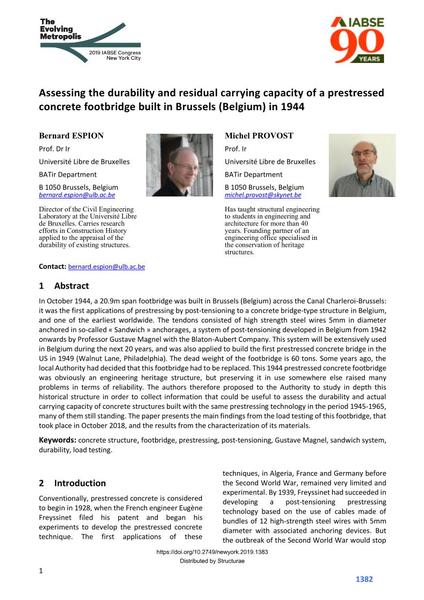Assessing the durability and residual carrying capacity of a prestressed footbridge built in Brussels (Belgium) in 1944

|
|
|||||||||||
Bibliographic Details
| Author(s): |
Bernard Espion
Michel Provost (Université Libre de Bruxelles, BATir Department) |
||||
|---|---|---|---|---|---|
| Medium: | conference paper | ||||
| Language(s): | English | ||||
| Conference: | IABSE Congress: The Evolving Metropolis, New York, NY, USA, 4-6 September 2019 | ||||
| Published in: | The Evolving Metropolis | ||||
|
|||||
| Page(s): | 1382-1387 | ||||
| Total no. of pages: | 6 | ||||
| Year: | 2019 | ||||
| DOI: | 10.2749/newyork.2019.1383 | ||||
| Abstract: |
In October 1944, a 20.9m span footbridge was built in Brussels (Belgium) across the Canal Charleroi-Brussels: it was the first applications of prestressing by post-tensioning to a concrete bridge-type structure in Belgium, and one of the earliest worldwide. The tendons consisted of high strength steel wires 5mm in diameter anchored in so-called « Sandwich » anchorages, a system of post-tensioning developed in Belgium from 1942 onwards by Professor Gustave Magnel with the Blaton-Aubert Company. This system will be extensively used in Belgium during the next 20 years, and was also applied to build the first prestressed concrete bridge in the US in 1949 (Walnut Lane, Philadelphia). The dead weight of the footbridge is 60 tons. Some years ago, the local Authority had decided that this footbridge had to be replaced. This 1944 prestressed concrete footbridge was obviously an engineering heritage structure, but preserving it in use somewhere else raised many problems in terms of reliability. The authors therefore proposed to the Authority to study in depth this historical structure in order to collect information that could be useful to assess the durability and actual carrying capacity of concrete structures built with the same prestressing technology in the period 1945-1965, many of them still standing. The paper presents the main findings from the load testing of this footbridge, that took place in October 2018, and the results from the characterization of its materials. |
||||
| Keywords: |
footbridge durability prestressing post-tensioning concrete structure load testing
|
||||
